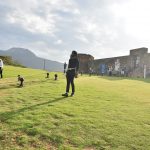Hijo de haitiano (Child of Haitian)
Independence POP, Museo Fortaleza San Felipe, Puerto Plata, Dominican Republic.
For many years the Haitian immigration to the Dominican Republic was linked to the sugar industry. In 1952 the governments of the Dominican Republic and Haiti signed an agreement to regularize the massive and temporary immigration of Haitian laborers working on the sugarcane harvest. After years of work, many day-laborers settled in the bateyes with their families and did not return to Haiti.
On December 10 of 2007, the Central Electoral Board of the Dominican Republic issued Resolution No. 12, which “provisionally suspends the issuance of Civil Status Records that contain irregularities.” Since then, thousands of Dominicans of Haitian descent became denationalized. Tangibly, this resolution denies them access to higher education, ID and passport, property acquisition, bank accounts, as well as legal marriage and child registration.
Outside of the Fort San Felipe there is a Dominican man on a horse. Tied to the horse saddle a rope extends towards and into the museum, with the other end tied to my waist. After several minutes, I am abruptly forced out of the building due to the horse’s pull.






